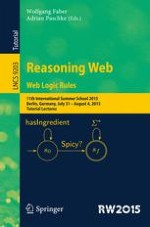2015 | OriginalPaper | Buchkapitel
PSOA RuleML: Integrated Object-Relational Data and Rules
verfasst von : Harold Boley
Erschienen in: Reasoning Web. Web Logic Rules
Aktivieren Sie unsere intelligente Suche, um passende Fachinhalte oder Patente zu finden.
Wählen Sie Textabschnitte aus um mit Künstlicher Intelligenz passenden Patente zu finden. powered by
Markieren Sie Textabschnitte, um KI-gestützt weitere passende Inhalte zu finden. powered by
